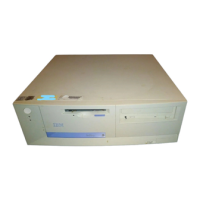





Do you have a question about the IBM NetVista A40 and is the answer not in the manual?
| Optical Drive | CD-ROM or DVD-ROM |
|---|---|
| Expansion Slots | 3 PCI, 1 AGP |
| Processor | Intel Pentium III |
| Chipset | Intel 815 |
| RAM | 64 MB to 512 MB SDRAM |
| Hard Drive | 20 GB to 40 GB |
| Graphics | Integrated Intel 3D Graphics |
| Audio | Integrated AC'97 |
| Network | Integrated Ethernet |
| Operating System | Windows 2000, Windows XP |
| Front Side Bus | 133 MHz |
| USB Ports | 2 USB 1.1 |
Precautions and warnings related to lithium battery replacement and disposal.
Safety guidelines for using telephone equipment to reduce risks.
Compliance information regarding laser safety standards and operation.
Guidance on finding additional information about the computer and IBM products.
How to identify your specific IBM NetVista computer model number.
Description of the small form factor desktop computer models.
Description of the standard desktop computer models.
Overview of the computer's key features, including microprocessor, memory, and drives.
Guidelines for choosing a suitable and safe location for the computer.
Instructions for connecting all necessary computer cables and peripherals.
Steps to correctly power on your computer and connected monitor.
Procedures to complete initial setup and record identification numbers.
Tips for setting up an ergonomic and efficient workspace for comfort.
Advice on optimizing monitor placement and lighting to minimize glare.
Ensuring proper airflow to prevent overheating and maintain performance.
How to properly start up your IBM NetVista computer.
Understanding and configuring the computer's video capabilities and modes.
How to use the computer's integrated audio controller and connectors.
Steps to update system programs like BIOS and POST via diskette or network.
Overview of security features like passwords, Asset ID, and chip protection.
Measures to protect your data from loss, viruses, and unauthorized access.
Instructions for safely cleaning computer components like the keyboard and screen.
How to access and navigate the system's BIOS setup utility.
Modifying various system configuration settings via the utility.
Customizing security features like enhanced security and profiles by device.
Setting and managing power-on and administrator passwords for security.
Procedure to reset forgotten passwords by clearing the CMOS settings.
Configuring energy-saving settings for the computer and monitor.
Precautions to prevent damage from static electricity during installation.
Step-by-step guide to safely remove the computer's outer cover.
Identifying internal components in the small form factor desktop model.
Instructions for installing system memory modules (DIMMs).
Guidance on installing expansion adapters into PCI/AGP slots.
Procedures for installing internal drives like hard disks and CD-ROMs.
Final steps after installing options, including reassembly and configuration.
A systematic approach to identifying and solving computer problems.
Understanding the POST sequence and its error messages.
A list of POST error codes and their corresponding actions.
Interpreting beep codes that indicate hardware issues and probable causes.
Charts to help diagnose problems with specific computer devices.
Solutions for common computer startup and general operational issues.
Troubleshooting steps for various monitor display issues.
Diagnosing and resolving issues related to computer memory installation.
Accessing IBM support and product information online resources.
Leveraging manuals and diagnostic tools for problem-solving and support.
How to contact IBM for technical assistance and hardware repair services.
Overview of the diagnostic and support software available on the CD.
Instructions for launching the software selections program from the CD.
Detailed technical specifications for the small form factor desktop models.
Detailed technical specifications for the A40 and A40p desktop models.
Detailed technical specifications for the A20 desktop model.
Instructions for orienting the small form factor computer vertically.
Instructions for orienting the standard desktop computer vertically.
Compliance information regarding electronic emissions for the computer.
FCC compliance information and guidelines for interference.
Important safety information and specifications regarding the computer's power cord.